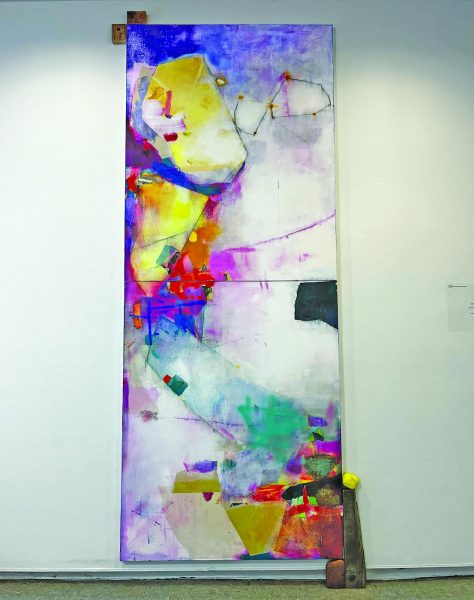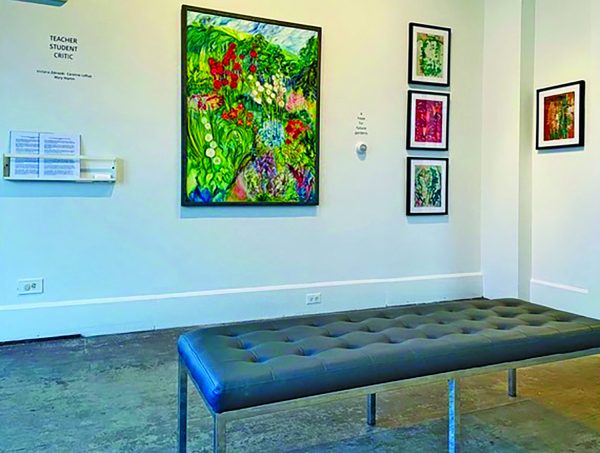“Streetcar” stays on track
We were warned: It was apparent before even entering Dibden Theatre that “A Streetcar Named Desire” dealt with adult themes. The sign outside the door told us as a much, warning of gunshots and rape.
Directed by Professor of Performing Arts Russ Longtin, and assistant-directed by Stephanie Zello, a junior, this iconic American play written by Tennessee Williams in 1947 was as vital, intense and shocking as it must have seemed to audiences more than 60 years ago.
Clearly, the performance benefitted from what was a well-orchestrated collective effort, beginning with the set, built and co-designed by Nick Ray, the other co-designer being Russ Longtin. Evoking a New Orleans house from the 1940’s it depicted the downstairs of a house with an authentic-looking staircase with banisters made of old, worn wood that led to an upstairs residence above the main house. The furniture, mainly the floral-printed armchair in the living room, looked as if it had been well-used for years. A simple screen door served as the entrance to the house, which almost always slammed closed. Authenticity extended to two black-and-white framed photographs hanging from the walls: one of the main couple that lived in the house, and one of a large estate (presumably the one the sisters in the play talked about recently losing). It was a subtle addition that contributed to the authenticity of the set.
Also important to authenticity were the props, especially the bottles of what appeared to be liquor. Prop master was Taylor Brown.
The play opened with Stella and Stanley (portrayed by Sam Killbride and Josh Baughn), going about their regular lives, when Stella’s sister Blanche (Heather Vize-Willey) surprises them by coming to stay with them for a while. Blanche witnesses, and is shocked by, the everyday lives of her sister and brother-in-law – from his violent outbursts to his loud and obnoxious poker games with his friends (Colton White, Shawn Weibel, and Sam Lewis). With the help of the owner of the property, who also lives in the upstairs apartment, (Chelsey Staples), Stella soon comes to see how barbaric and cruel Stanley really is; but not before her sister’s lies are exposed, revealing her to be horribly scarred by her past. Minor characters included a woman handing out flowers on the street (Athena Theresa), the newspaper money collector (Matthieu J. Ruelle), and the doctor and nurse that come to take Blanche away (Adam Nowak and Hannah Publicover).
Under the deft direction of Longtin, for the most part, the performers did justice to the intensity and drama of the play.
Killbride’s performance probably struck me the most. Her lines were tinged with emotion, as she moved with apparent ease from sarcasm to pain, to anger, to joy. When she wasn’t delivering lines, she could be seen fighting back tears, doubled over sobbing, shaking her head and rolling her eyes, all intense without being over the top.
Baughn as Stanley, a character prone to violent outbursts of rage, punctuated his shouts by occasionally slamming his fist on the counters, table tops, and doors, causing me and others around me to jump, feeling the fear the other characters were experiencing. His simmering rage was not lost on the audience.
Vize-Willey portrayed a nervous, possibly mentally disturbed woman convincingly with her hasty, stumbling sentences. Her well choreographed body language worked well – for example fiddling with her fingers anxiously as she went off on a long-winded, painful recollection from her past. Sometimes it’s the smaller motions that have disproportionate effect.
Whenever Blanche was experiencing these memories and flashbacks, an accordion polka tune would play, sometimes ending with a gunshot, which represented the night she went dancing, the same night she witnessed her then-husband kill himself. The sound technician in charge of this was Zane Watkins, whose acoustic design enhanced the dramatic effect of the play.
The previously forewarned rape scene was subtle, but effective. The rape was implied rather than shown, showing Stanley and Blanche arguing, Stanley knocking her out and then carrying her to the bed, the scene ending with him standing over her. Before the scene faded out, Stanley uttered the chilling line, “We’ve had this date from the beginning.”
Enhancing the intensity was the lighting work by Henry George, who emphasized the drama and anger of the scene by shrouding the stage in red. The effectiveness of the scene was reflected by the audience, which became hushed with rapt attention.
There were light moments too, despite the gravity of the play. Chuckles from the audience could also be heard throughout the show, especially at one part when the cord kept falling off the phone when Josh Baughn was trying to use it. It’s unclear as to whether it was actually planned as part of the show, but nonetheless, they played off it well, with a nonchalant, “We really need to get that fixed.”
The characters’ costumes (designed by Samantha Drouin) added to the authenticity of the production, being accurate for the time period with suits and ties, colorful but modest dresses, slips and nightgowns.
Kathryn Finegan was the stage manager for the production, with Mackenzie Brown as the assistant stage manager.
Overall, the production offered a powerful rendition of this American classic, largely due to the combined efforts and contributions of the director, cast, and crew. It’s a shame that more people did not experience this production on Friday the 13th.
Jeffrey joined the Basement Medicine staff in the Spring 2015 semester serving as staff writer and photo editor.









